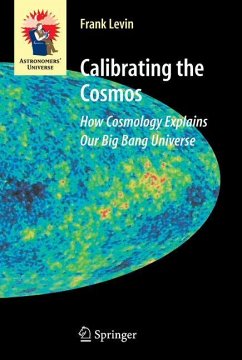Calibrating the Cosmos describes hard science, but is gently written. It explains in clear, non-mathematical language the measurements and the interpretation of the resulting data that have led to the current understanding of the origin, evolution and properties of our expanding Big Bang universe.
Many people have a sketchy idea of the work of cosmologists, but Professor Levin's experience in teaching both scientific and liberal arts students has enabled him to impart much of our current thinking without resorting to difficult mathematics. Theoretical concepts are emphasized, in particular the symmetries of homogeneity and isotropy enjoyed by our universe on the largest scales, how these symmetries lead to only one quantity being needed to describe the growth of the universe from its infancy to the present time, and how the so-called parameters of the universe are the ingredients used to construct the model universes to which ours - the real thing - is compared.
Levin includes the 2003 results from the Wilkinson Microwave Anisotropy Probe (WMAP) and the 2003 and 2004 results of the Sloan Digital Sky Survey to ensure that the book is up to date. He explains the relevance of the discoveries done by the new physics Nobel laureates Smoot and Mather!
Background material is provided in the first four chapters; the current picture and how it was attained are discussed in the next four chapters; and some unsolved problems and conjectured solutions are explored in the final chapter.
Many people have a sketchy idea of the work of cosmologists, but Professor Levin's experience in teaching both scientific and liberal arts students has enabled him to impart much of our current thinking without resorting to difficult mathematics. Theoretical concepts are emphasized, in particular the symmetries of homogeneity and isotropy enjoyed by our universe on the largest scales, how these symmetries lead to only one quantity being needed to describe the growth of the universe from its infancy to the present time, and how the so-called parameters of the universe are the ingredients used to construct the model universes to which ours - the real thing - is compared.
Levin includes the 2003 results from the Wilkinson Microwave Anisotropy Probe (WMAP) and the 2003 and 2004 results of the Sloan Digital Sky Survey to ensure that the book is up to date. He explains the relevance of the discoveries done by the new physics Nobel laureates Smoot and Mather!
Background material is provided in the first four chapters; the current picture and how it was attained are discussed in the next four chapters; and some unsolved problems and conjectured solutions are explored in the final chapter.
From the reviews:
"Levin (emer., Brown Univ.) has based his book on his lectures for adult education classes ... . Judicious use of numbers, equations, illustrations, and graphs help the reader understand the verbal descriptions. ... Summing Up: Recommended. General readers; lower-division undergraduates; two-year technical program students." (M. Dickinson, CHOICE, Vol. 44 (9), May, 2007)
"For those wishing to learn more about the universe and its origins, a good place to begin is Frank Levin's Calibrating the Cosmos. ... Levin makes far more use of charts and graphs to illustrate his discussion of astronomical concepts like the Hubble Constant. ... Calibrating the Cosmos aimed at a particular audience: people who don't know much about cosmology, but who are relatively intelligent and motivated to learn." (Jeff Foust, The Space Review, June, 2007)
"Calibrating the Cosmos is the first in a series of Astronomers' Universe titles that attempt to bring front-line astronomy research to the informed amateur astronomer and scientist. The aim is ambitious - to provide a quantitative yet descriptive account of the evolution of the Universe and its contents ... . The discussion is supported by an impressive array of appendices, chapter notes, a bibliography (including internet-based sources), a glossary, and symbol definitions! This book will serve best the keen amateur astronomer and scientist ... ." (Jon Willis, The Observatory, Vol. 127 (1200), October, 2007)
"American physicist Frank Levin has written a comprehensive and authoritative introduction to cosmology - the science that deals with the origin, evolution and ultimate fate of the universe. Levin's book is based on lectures he gave in several-adult education courses. ... we'd recommend ... to anyone who wants to get to grips with a weighty but rewarding subject." (Marcus Chown, BBC Sky at Night, May, 2007)
"Calibrating the Cosmos is the first volume inthe new series from Springer called Astronomers Universe, intended for just about anyone with a measure of curiosity. ... With diagrams and even one or two colour photos the value is excellent and I can recommend it without reservation." (Bill Barlow, Astronomy Now, June, 2007)
"Frank Levin currently teaches cosmology to adults who lack the scientific and mathematical background that would usually be regarded as a sine qua non for anyone embarking on such a course of study. His latest book, Calibrating the Cosmos, grew out of this work and promises to bring the science of modern cosmology within reach of the lay reader." (Brendan K Ward, Astronomy and Space, October, 2007)
"Levin (emer., Brown Univ.) has based his book on his lectures for adult education classes ... . Judicious use of numbers, equations, illustrations, and graphs help the reader understand the verbal descriptions. ... Summing Up: Recommended. General readers; lower-division undergraduates; two-year technical program students." (M. Dickinson, CHOICE, Vol. 44 (9), May, 2007)
"For those wishing to learn more about the universe and its origins, a good place to begin is Frank Levin's Calibrating the Cosmos. ... Levin makes far more use of charts and graphs to illustrate his discussion of astronomical concepts like the Hubble Constant. ... Calibrating the Cosmos aimed at a particular audience: people who don't know much about cosmology, but who are relatively intelligent and motivated to learn." (Jeff Foust, The Space Review, June, 2007)
"Calibrating the Cosmos is the first in a series of Astronomers' Universe titles that attempt to bring front-line astronomy research to the informed amateur astronomer and scientist. The aim is ambitious - to provide a quantitative yet descriptive account of the evolution of the Universe and its contents ... . The discussion is supported by an impressive array of appendices, chapter notes, a bibliography (including internet-based sources), a glossary, and symbol definitions! This book will serve best the keen amateur astronomer and scientist ... ." (Jon Willis, The Observatory, Vol. 127 (1200), October, 2007)
"American physicist Frank Levin has written a comprehensive and authoritative introduction to cosmology - the science that deals with the origin, evolution and ultimate fate of the universe. Levin's book is based on lectures he gave in several-adult education courses. ... we'd recommend ... to anyone who wants to get to grips with a weighty but rewarding subject." (Marcus Chown, BBC Sky at Night, May, 2007)
"Calibrating the Cosmos is the first volume inthe new series from Springer called Astronomers Universe, intended for just about anyone with a measure of curiosity. ... With diagrams and even one or two colour photos the value is excellent and I can recommend it without reservation." (Bill Barlow, Astronomy Now, June, 2007)
"Frank Levin currently teaches cosmology to adults who lack the scientific and mathematical background that would usually be regarded as a sine qua non for anyone embarking on such a course of study. His latest book, Calibrating the Cosmos, grew out of this work and promises to bring the science of modern cosmology within reach of the lay reader." (Brendan K Ward, Astronomy and Space, October, 2007)
Aus den Rezensionen: "... ein logischer und didaktischer Kunstgriff ... Frank Levin ... stellt ... die Grundlagen der Vermessung des Universums klar und systematisch vor, was den Wert des Bandes ausmacht. Levin ... legt ... großen Wert auf die Vermittlung von Zahlen und astronomischen Größenordnungen, Ausweis seiner guten physikalischen Didaktik aus dreißig Jahren akademischer Lehre. ... Der Band ist sehr gut mit Anhängen zur kosmischen Elementsynthese ... ausgestattet. ... Allen Liebhabern der Kosmologie ... sei der Band zur aufmerksamen Lektüre empfohlen." (Volker Müller, in: Sterne und Weltraum, 2008, Issue 5, S. 122)








